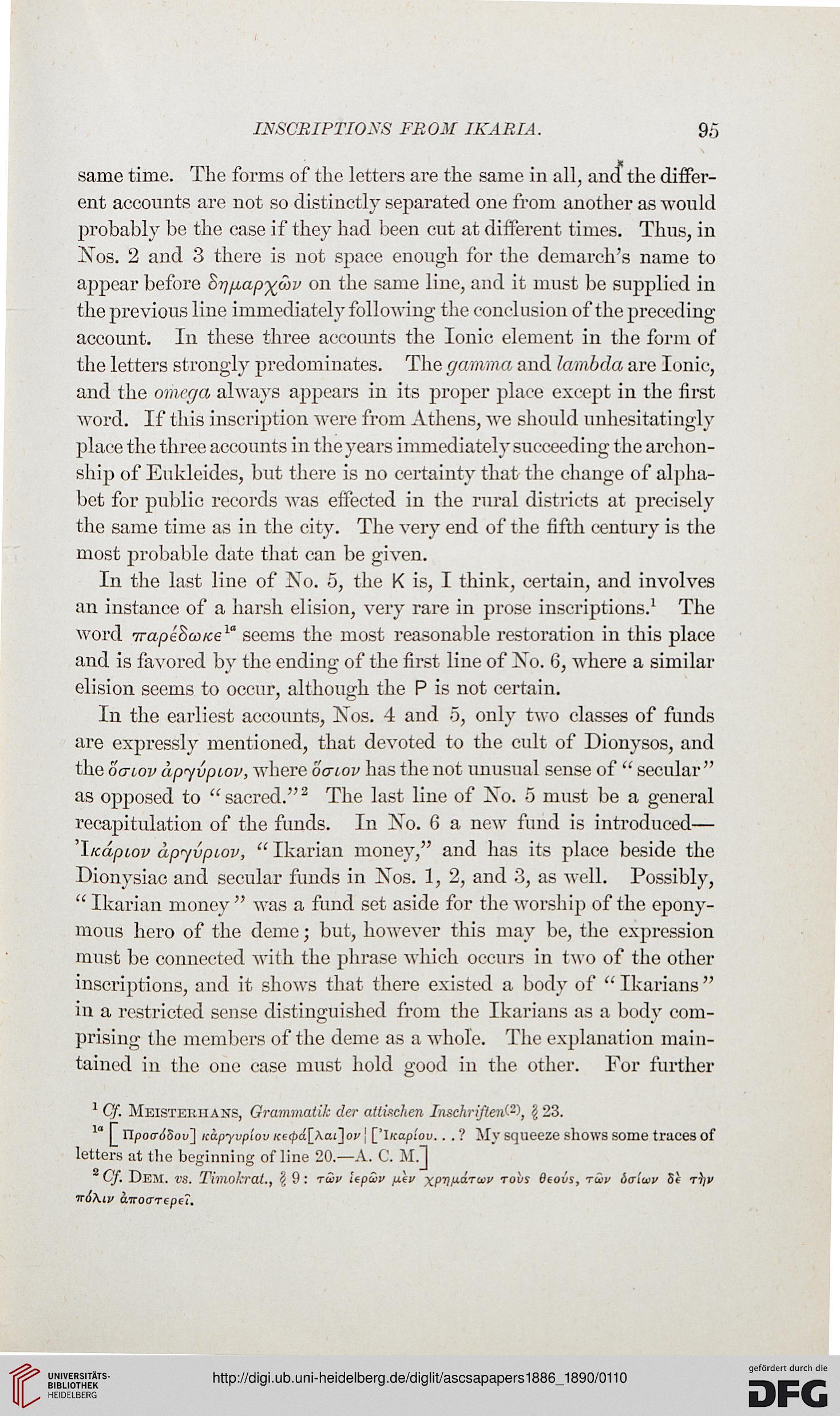INSCBIPTIOyS FROM IK ARIA.
95
same time. The forms of the letters are the same in all, and* the differ-
ent accounts are not so distinctly separated one from another as would
probably be the case if they had been cut at different times. Thus, in
Nos. 2 and 3 there is not space enough for the demarch's name to
appear before Srjfiap^MV on the same line, and it must be supplied in
the previous line immediately following the conclusion of the preceding
account. In these three accounts the Ionic element in the form of
the letters strongly predominates. The gamma and lambda are Ionic,
and the omega always appears in its proper place except in the first
word. If this inscription were from Athens, we should unhesitatingly
place the three accounts in the years immediately succeeding the archon-
ship of Eukleidcs, but there is no certainty that the change of alpha-
bet for public records was effected in the rural districts at precisely
the same time as in the city. The very end of the fifth century is the
most probable date that can be given.
In the last line of No. 5, the K is, I think, certain, and involves
an instance of a harsh elision, very rare in prose inscriptions.1 The
word irapehaice1' seems the most reasonable restoration in this place
and is favored bv the ending of the first line of No. 6, where a similar
elision seems to occur, although the P is not certain.
In the earliest accounts, Nos. 4 and 5, only two classes of funds
are expressly mentioned, that devoted to the cult of Dionysos, and
the oaiov apyvpiov, where ocriov has the not unusual sense of " secular "
as opjiosed to " sacred."2 The last line of Xo. 5 must be a general
recapitulation of the funds. In No. 6 a new fund is introduced—
'I/cdpiov apyupiov, " Ikarian money," and has its place beside the
Dionysiac and secular funds in Nos. 1, 2, and 3, as well. Possibly,
" Ikarian money " was a fund set aside for the worship of the epony-
mous hero of the deme; but, however this may be, the expression
must be connected with the phrase which occurs in two of the other
inscriptions, and it shows that there existed a body of " Ikarians "
in a restricted sense distinguished from the Ikarians as a body com-
prising the members of the deme as a whole. The explanation main-
tained in the one case must hold good in the other. For further
1 Cf. Meisterhans, Grammalik der allixchen InschriftenW, I 23.
10 f Upoa6Sov} itipyvplov Keipa[\ai]or [ ['iKapiou.. . ? My squeeze shows some traces of
letters at the beginning of line 20.—A. C. M.]
s Cf. Dem. vs. Timokrat., \ 9: rwv Upuv pXv XPV^T">" r<"'^ Btovs, ruiy ba'iwv 5f tV
tt6\lv airoffTepeT.
95
same time. The forms of the letters are the same in all, and* the differ-
ent accounts are not so distinctly separated one from another as would
probably be the case if they had been cut at different times. Thus, in
Nos. 2 and 3 there is not space enough for the demarch's name to
appear before Srjfiap^MV on the same line, and it must be supplied in
the previous line immediately following the conclusion of the preceding
account. In these three accounts the Ionic element in the form of
the letters strongly predominates. The gamma and lambda are Ionic,
and the omega always appears in its proper place except in the first
word. If this inscription were from Athens, we should unhesitatingly
place the three accounts in the years immediately succeeding the archon-
ship of Eukleidcs, but there is no certainty that the change of alpha-
bet for public records was effected in the rural districts at precisely
the same time as in the city. The very end of the fifth century is the
most probable date that can be given.
In the last line of No. 5, the K is, I think, certain, and involves
an instance of a harsh elision, very rare in prose inscriptions.1 The
word irapehaice1' seems the most reasonable restoration in this place
and is favored bv the ending of the first line of No. 6, where a similar
elision seems to occur, although the P is not certain.
In the earliest accounts, Nos. 4 and 5, only two classes of funds
are expressly mentioned, that devoted to the cult of Dionysos, and
the oaiov apyvpiov, where ocriov has the not unusual sense of " secular "
as opjiosed to " sacred."2 The last line of Xo. 5 must be a general
recapitulation of the funds. In No. 6 a new fund is introduced—
'I/cdpiov apyupiov, " Ikarian money," and has its place beside the
Dionysiac and secular funds in Nos. 1, 2, and 3, as well. Possibly,
" Ikarian money " was a fund set aside for the worship of the epony-
mous hero of the deme; but, however this may be, the expression
must be connected with the phrase which occurs in two of the other
inscriptions, and it shows that there existed a body of " Ikarians "
in a restricted sense distinguished from the Ikarians as a body com-
prising the members of the deme as a whole. The explanation main-
tained in the one case must hold good in the other. For further
1 Cf. Meisterhans, Grammalik der allixchen InschriftenW, I 23.
10 f Upoa6Sov} itipyvplov Keipa[\ai]or [ ['iKapiou.. . ? My squeeze shows some traces of
letters at the beginning of line 20.—A. C. M.]
s Cf. Dem. vs. Timokrat., \ 9: rwv Upuv pXv XPV^T">" r<"'^ Btovs, ruiy ba'iwv 5f tV
tt6\lv airoffTepeT.




